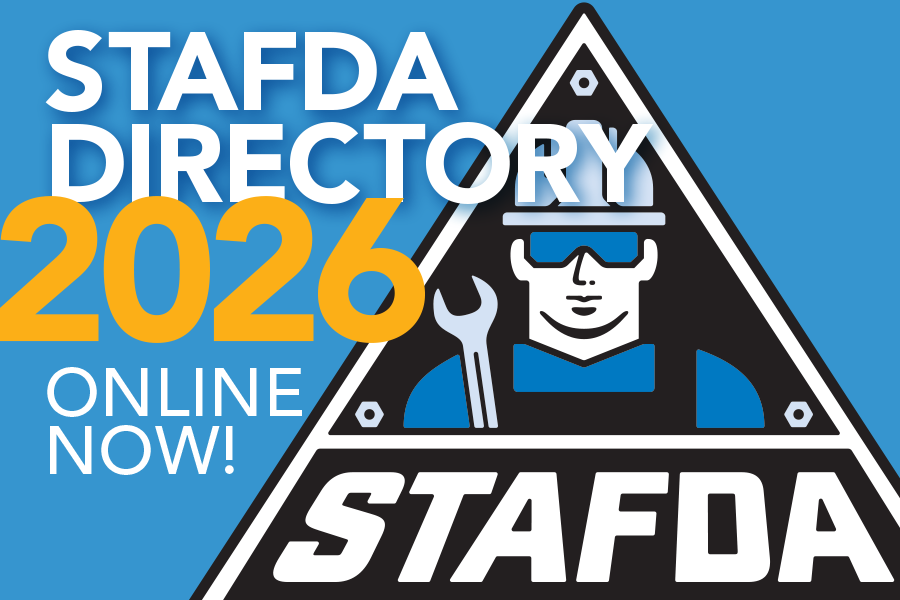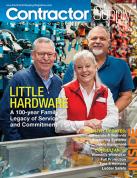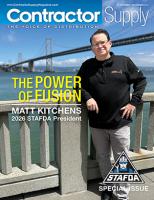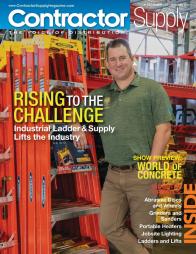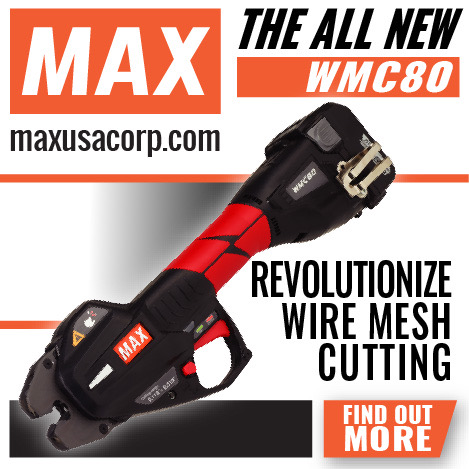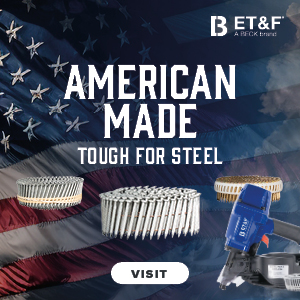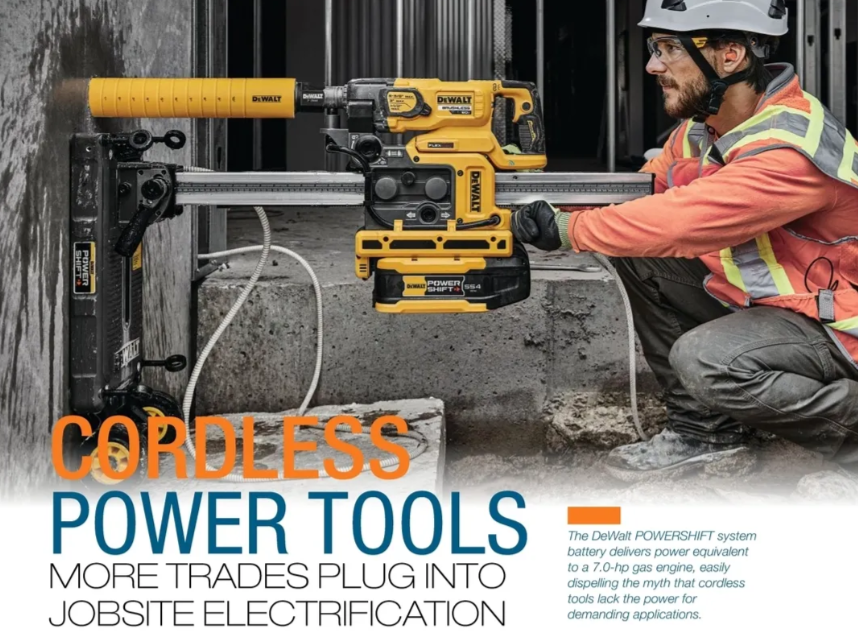 |
Leaders in the cordless power tools market are making significant research and development investments to enhance the availability and differentiation of their products. In 2025, geopolitical tensions involving tariffs, export controls and more restricted access to raw materials, have had an impact on production costs and overall pricing. Despite these challenges, the cordless power tools market remains on the rise as manufacturers continue to push the boundaries of technology with new advancements for use of cordless tools in more high-capacity applications.
DEWALT
One of the most significant trends in the cordless power tools industry is the shift from gas-powered to battery-powered tools in high-capacity applications like concrete and masonry.
Bill Harman, vice president of product management, commercial and general construction, DeWalt, says a common misconception is that transitioning from gas-powered equipment to cordless power tools means compromising efficiency and performance.
However, he says recent surveys of construction professionals, led by DeWalt, found that while power supply (39%) and tool durability (35%) are concerns regarding battery-powered tools, 72% of respondents who have switched to these tools on jobsites say it has allowed them to complete projects up to two to three times faster compared to gas-powered tools.
Furthermore, Harman says 94% of electric-powered tool users say they are either satisfied or very satisfied with the transition to electric-powered tools on their construction site.
“This shift to cordless innovation addresses several challenges faced across a variety of trades,” he says.
First, gas tools require consistent maintenance, much like any motor-powered equipment.
“Cordless power tools can sit unused for days or weeks while crews wait for the next job,” Harman says.
In addition, unlike the regular maintenance of filters and oil changes, the electric tools have minimum maintenance requirements, containing significantly less moving parts that are susceptible to wear and tear.
Harman also says cordless power tools tend to be quieter than gas tools, creating a better work environment.
“Gas engines can emit noise up to 130 decibels and often are right next to the user’s ears,” he says. “With quieter operation, workers can have conversations without needing to yell or shut down equipment to be heard.”
From an efficiency standpoint, gas-powered equipment includes the notion of safely storing gasoline on a jobsite. When gas runs out, Harman notes that users must stop working, get more gas from storage, fill the machine, store the remaining gas, and continue working.
“With most cordless power tool batteries, including DeWalt’s high-capacity POWERSHIFT batteries, you can reach a full charge in less than an hour and they can be swapped out with another fully charged battery so there is little to no downtime,” Harman says.
As for overall power, he notes that the DeWalt POWERSHIFT system battery delivers power equivalent to a 7.0-hp gas engine, easily dispelling the myth that cordless tools lack the power for demanding applications.
Harman sees electrification of jobsites as something that will continue to advance as more cordless tools and battery solutions are developed.
“The industry is also ready for this shift,” he says.
Over the next few years, Harman says a key priority for DeWalt is acceleration of the transition to cordless solutions across a wider range of trades.
“The DeWalt POWERSHIFT system is a more recent example of taking traditionally larger gas-powered concrete equipment and electrifying it across concrete and construction job sites,” he says.
The line includes a vibrator, backpack vibrator, concrete power screed, rammer, plate compactor, core drill and stand, 554WH battery and 550W charger.
“The equipment is also ergonomic, light weight, and user-friendly with features like soft start, to help less experienced skilled workers adjust to using these high-performance tools,” he says.
Additionally, Harman says DeWalt is committed to advancing the connected jobsite. Technologies like TOOL CONNECT+ allow for asset management, reviewing critical safety event data and even understanding utilization patterns to make users and jobsites safer and more productive.
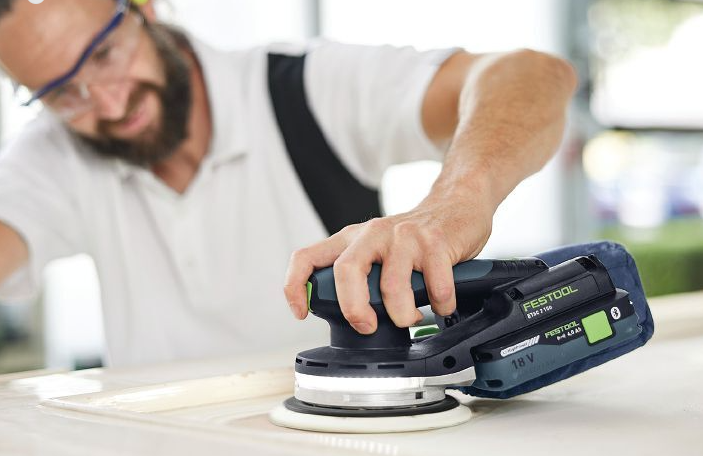 |
| Festool’s cordless random orbit sander, the ETCS 2 125/150, is designed for virtually dust-free sanding with a dust collection bag and no suction hose to slow down the work. |
FESTOOL
From the distributor’s point of view, the bare tool options are lighter to ship, have fewer shipping restrictions and requirements, and take less space on the shelf or warehouse.
Festool recently launched a 5-inch and 6-inch cordless sander equipped with an integrated LED light to illuminate surface areas for improved visibility. Another recent cordless product Festool has introduced is the EXO 18 ExoActive Exoskeleton which can run through an entire day on a 4.0 Ah battery.
“We will continue to see more incremental improvements in technology and broadening product portfolios,” says Rick Bush, senior marketing manager at Festool.
He notes that Festool has been steadily improving the breadth and depth of its cordless offering by providing power tools that don’t compromise on performance, rivaling their corded counterparts, while also including new features.
“Tools have to be durable, reliable, and powerful,” he says.
As with most cordless power tool manufacturers, Bush says run time and power are usually the two things consumers are concerned about.
“At this stage, brushless motors, on-board electronics, and ever-improving energy density in batteries combine for performance that is on-par with corded tools,” he says. Ongoing advances in battery technology remains a key driving factor in cordless tools.
For example, Bush says Bluetooth-equipped batteries provide several benefits, such as tool-triggered dust extraction activation as well as the opportunity to pair to a smartphone.
Festool offers an app both for iOS and Android that offers benefits such as an online fleet tool list, remote functionality and control for features like integrated LED controls, speed settings, pre-set angles on a table saw, and more.
“The app even features a software update feature for batteries and tools to optimize performance, and all of this is provided free of charge,” Bush says.
As for pricing, he says many manufacturers are offering more “bare tool” options or tools sold without batteries for existing platforms.
“This provides customers more flexibility and options to increase their tool libraries at a lower price point,” he says.
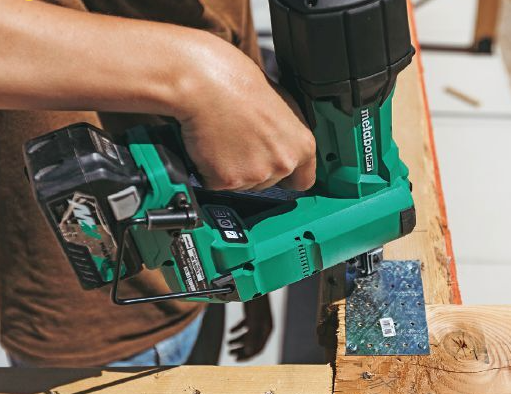 |
| The NR1838DKA is an integral part of Metabo HPT’s expanding MultiVolt System of 18-Volt and 36-Volt power tools. The dual compatiblity provides more power and flexibility among tools. |
METABO HPT
A common perception in the construction tool market is that cordless tools inherently lack the power of their corded or pneumatic counterparts.
Metabo HPT directly addresses this by emphasizing tools such as the NR1838DKA 18V MultiVolt Brushless Metal Connector Nailer’s 77 joules of power output and its performance mirroring that of a pneumatic tool.
“This is not just a technical specification; it is a strategic message aimed at debunking a long-held belief,” says Mitch Kumakura, senior product manager at Metabo HPT. “By achieving pneumatic-like power in a cordless form factor, Metabo HPT positions the NR1838DKA as a transformative product, directly addressing the primary concern of professional users who prioritize raw power and efficiency.”
He adds that the performance parity is crucial for driving adoption and establishing cordless tools as viable, if not superior, alternatives in demanding applications.
Similarly, Kumakura says the NR1838DKA’s integration into Metahbo’s MultiVolt system and its reliance on brushless motor technology are deeply connected to broader industry trends.
“The growth of the cordless power tools market is largely fueled by advancements in battery technology, particularly the shift to more efficient and compact lithium-ion batteries,” he says. “Brushless motors, as highlighted, offer superior efficiency, durability, and reduced operating costs. By combining these, Metabo HPT is not only enhancing the performance of individual tools but also investing in a scalable and future-proof platform.”
The nailer and other tools are compatabile with both 18V/36V MultiVolt batteries, minimizing the need for multiple battery types. Use of the system encourages users to commit to a broader battery ecosystem and are less likely to switch brands, thereby securing long-term revenue streams beyond single tool purchases for both the distributor and the manufacturer.
Brushless motors are widely recognized for their efficiency in converting electrical energy into motion, significantly reducing energy loss through heat. In addition, they require less maintenance and tend to be more durable.
“This technological choice directly translates into lower long-term operating costs and increased productivity for the user,” Kumakura says. “The combination of these two core technologies allows the NR1838DKA to offer a compelling alternative to traditional pneumatic systems.”
LEARN MORE
This article originally appeared in the October/November 2025 issue of Contractor Supply magazine. Copyright 2025, Direct Business Media.





